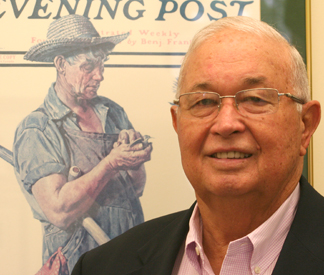FFA Foundation Renews 30-Year-Old Push For $1 Million Goal

A gallon of gas for 63 cents, a pound of bacon AND a dozen eggs for $1.68 and a new home for $54,800.It may sound like the best of times, but 1978 was the worst of times for an America on the brink of an energy crisis. Consumers were saddled with debts they couldn’t repay, runaway inflation hovered at 7.62 percent and unemployment was 6.1 percent.Even so, it was under those oh-so-familiar conditions three decades ago that a group of Alabama’s agricultural leaders joined together with an admirable — if not ambitious — goal to raise $1 million for the state’s Future Farmers of America programs. And it’s under similar circumstances that the stalled 30-year-old push to reach that goal has been revived by the FFA Foundation.”I just thought it was time to finish the job we started 30 years ago, and to try again to reach $1 million to fund this program,” said Doug Rigney, a deputy commissioner with the Alabama Department of Agriculture and Industries who also serves as chairman of the Foundation.That’s why Rigney, a former executive director of the Alabama Farmers Federation, recently mailed out several hundred letters to “interested parties,” such as Team AgEd members, Foundation board members, FFA officer alumni and others urging each of them to raise $5,000. “I firmly believe that if we can raise $200,000 from individuals, we can then turn to the agri-business community for the remaining funds,” Rigney’s letter read.Troy Newton, who recently retired after 18 years as FFA executive secretary but still serves as the Foundation board’s secretary-treasurer, said the Foundation was established as a non-profit trust that would use the interest from the $1 million principal to fund FFA programs or career development events. “That’s the judging contests, travel expenses for FFA officers and their attendance at state and national conventions, visiting local chapters,” said Newton. “Some of that money goes to state winners that go to national FFA competition, and it helps chapters pay for plaques, trophies and banners.”It’s not known exactly how much the Foundation raised for its original nest egg, but the pot now stands at about $600,000 — a figure that surprises many of the principals in the initial effort.”If we didn’t finish our job, shame shame on us!” said State Treasurer Kay Ivey, who was then a state officer for the Future Homemakers of America (FHA) which also aided in the effort. “At the same time, it sounds like they’ve been good stewards of what money they had. Maybe it’s time for us to rally again.”Ivey credits the late Mary George Waite, a Cherokee County banker who was on the board of the 4-H Foundation, as being the impetus behind the FFA Foundation. “She had an interest in FFA and FHA and rural counties,” Ivey recalled. “We all had an interest in helping these young people, but there wasn’t enough money to do all these things — much less pay for the calf show or the goat roping or whatever. So, I think Mary George said, ‘Why don’t we make this happen?’ So we just made phone calls and did the best we could and got it off and running.”John Dorrill, formerly an assistant to then-Federation President J.D. Hays, headed up the original group. “There was a lot of interest, a lot of enthusiasm,” said Dorrill. “I remember we raised a quarter of a million pretty quickly. … It was a good goal and a good group. We did some good things, and got some good things started.”That’s the kind of enthusiasm Rigney is hoping to generate once again. Despite a $75,000 contribution from the Alabama Farmers Federation four years ago, Rigney says Alabama FFA programs continue to lag behind those in other states.”As times have gone on and the fund has not grown to $1 million and costs have gone up, we need more money to produce more growth so we can fund more programs,” Rigney said. “We’ve been through some pretty difficult times with investments. Interest rates have been low, so our earning capacity has been low, but we’ve still had expenses.”In the meantime, Newton said, fund-raising efforts began to taper off. “It depended on the time we had to work on it as to how much was raised,” he said.As a comparison, Rigney points to Tennessee’s FFA Foundation, which has “$3 or $4 million” and a full-time development officer to raise funds. “It would be much better if we had a development officer,” he said, “but we don’t have enough funds to afford one. I think we could be as good as Tennessee.”Dorrill agrees that a development officer would help, but the funds have to be there to pay for it. “Everything has gotten so competitive now and with the economy in such dire straits, that would be very important,” Dorrill said. “It’s a fine program, and it’s not getting the interest and support it should.”Ivey, too, remains an ardent supporter. “It’s agri-business — it covers a lot more than small motor repair and how to feed the cows,” she said. “It’s still a very worthy organization. It builds leadership, organizational skills and public speaking skills in our young people and encourages them to seek leadership positions, not only in high school but in college and beyond.”So, Rigney reaches out — and beyond. “You know,” he said, “if you were an FFA member when you were growing up and you feel it has helped you be a more productive person in life, then I’d like to solicit your support to make it better for the future of young people today.”
______________________________________
Donations to the FFA Foundation are tax deductible. To make a donation, make your check payable to the Alabama FFA Foundation and mail to: Alabama FFA Association, Attn: FFA Foundation, P.O. Box 302101, Montgomery, AL 36130-2101. For more information, contact Rigney at (334) 240-7100 or doug.rigney@agi.alabama.gov.
